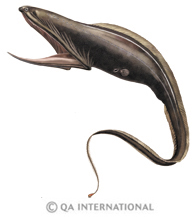
Fauna of the deep sea: life teeming in the darkness!
The sun’s rays barely penetrate the water past a depth of 200 m. Without sufficient light, marine plants cannot grow in deep waters and there are far fewer animals. Beyond a depth of 1,000 m is the midnight zone. Here it is completely dark. The water is cold, the pressure is crushing and food is rare. In spite of this, a number of unusual creatures can be found that have perfectly adapted to the inhospitable environment. They generally have a very supple body for withstanding the pressure. They often have a huge mouth, giving them more opportunity to gulp down any prey that may be passing by. Some animals use a chemical process called bioluminescence to produce light, allowing them to communicate, attract and also deceive. Others are sensitive to the least vibration and patiently wait for prey to brush past them, or for bits of food and animal carcasses to drift down from the surface.
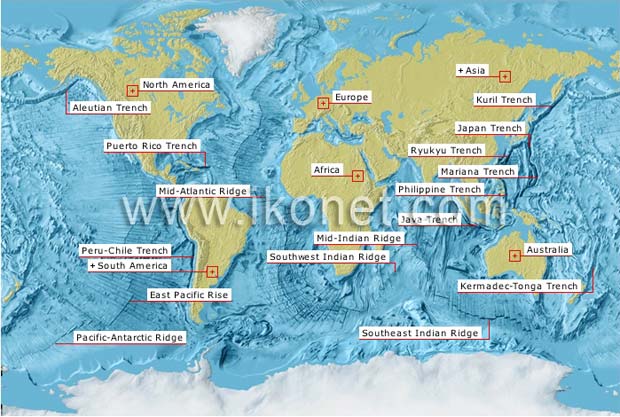 |
| Ocean trenches and ridges |
Pioneers of the depths
In 1934, humans managed for the first time to observe the animals of the depths. This exploit was achieved by two American explorers, William Beebe and Otis Barton. Thanks to the bathysphere, a large steel sphere attached by cable to a ship, they descended to a depth of 923 m. In 1960, Don Walsh and Jacques Piccard achieved another exploit. On board the bathyscaphe Trieste, they descended into an abyssal trench at a depth of 10,916 m, a record that has never been beaten! The bathysphere and the bathyscaphe were only able to move vertically. In 1965, Alvin became the first completely mobile submersible, capable of transporting passengers under water and easily exploring depths of up to 4,500 m!
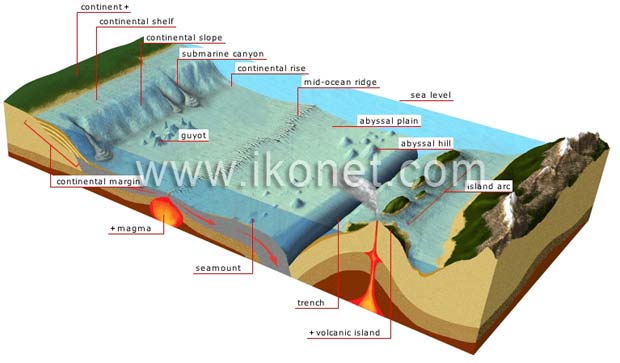 |
| Ocean floor |
The silver hatchetfish
Thanks to the luminuous dots sprinkling its belly, the silver hatchetfish benefits from a highly effective camouflage. Predators swimming underneath confuse the small fish’s points of light with the feeble rays of sunlight filtering down from the surface, hundreds of meters above them. These luminous dots may also be used for attracting the plankton that the silver hatchetfish eats or for communicating with its fellow creatures.
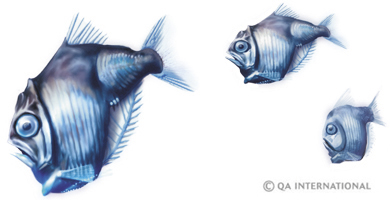 |
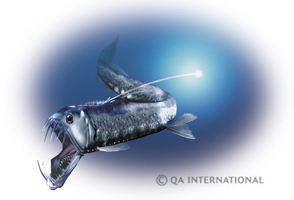 |
The viperfishThe viperfish has a streamlined body that can measure more than 30 cm long and a disproportionately large mouth equipped with fanglike teeth. Thanks to its expandable stomach and its jaws that open very wide, the viperfish can swallow and digest prey that is almost as large as itself! |
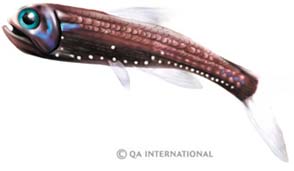 |
The lanternfishThere are numerous species of lanternfish scattered throughout the oceans of the world. They are probably the most abundant marine vertebrates . These small fish measuring 7 to 23 cm long get their name from the bioluminescent organs on their body. When night falls, schools of lanternfish leave the depths to feed on plankton close to the ocean’s surface. At daybeak, they return to the depths to escape the view of predators. |
The deep-sea anglerfish
The five species of anglerfish live at a depth of more than 1,000 m. The female anglerfish, which measures almost 20 cm in length, has a lure on her head that contains bioluminescent bacteria. She uses this luminous fishing rod to attract other fish, gulping them down in a flash with her enormous mouth lined with sharp teeth. The male, which is much smaller than the female, does not measure more than 3 cm.
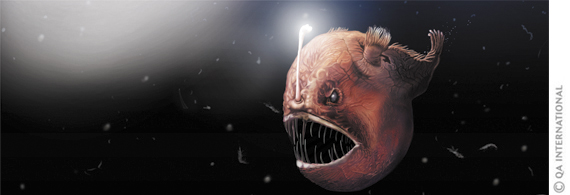 |
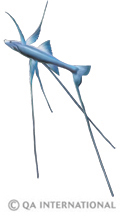 |
The tripod fishThe tripod fish, which grows to 40 cm in length, lives on the ocean floor at a depth of more than 4,000 m. It remains immobile on the seabed where it faces the current, balancing on the three long, rigid extensions of its fins. Settled on its “tripod”, the fish awaits its prey, which it easily detects through odor or vibrations in the water. The tripod fish is both male and female and can fertilize itself. |
|
|
The gulper eelThe gulper eel’s body measures almost 1 m long and is slit open in the front by a gigantic mouth. This fish of the great depths is equipped with a luminous organ at the tip of its tail. It uses it to attract a mate and perhaps prey, like small fish and invertebrates. Food is scarce nearby, so the gulper eel swims with its enormous mouth constantly open. In this way, it does not miss an opportunity to feed itself. |
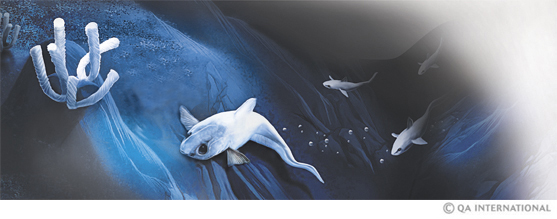 |
The giant squid
The giant squid is one of the largest invertebrates on the planet. Including its tentacles, it can measure more than 10 m long! The animal also has two gigantic eyes about 25 cm in diameter, which is about the size of a dinner plate. In the semidarkness of the ocean depths, these large eyes probably help it to spot its prey, which are fish and other squid, as well as its main predator, the sperm whale.
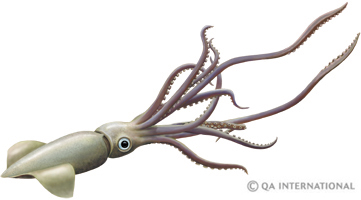
The sperm whale
The sperm whale is a toothed cetacean that can measure almost 20 m long and weigh more than 50 metric tons. Like all mammals, it must breathe air. Its favorite meal, however, is the giant squid, which lives at a depth of more than 1,000 m. To catch it, the sperm whale must dive, sometimes up to 3,000 m deep—a record for a mammal! It can hold its breath for more than an hour before returning to the surface to breathe.

The giant japanese spider crab
The Japanese spider crab is the largest crustacean in the world. Its body, which measures about 30 cm in diameter, is supported by long legs that span more than 3 m! They allow it to walk at a depth of several hundred meters on the ocean floor that surrounds Japan. It feeds mainly on animal carcasses. The spider crab is fished commercially in Japan, where its meat is a favorite dish.
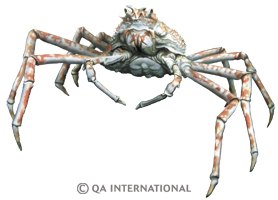
Also see:
In the Visual Dictionary:
- "Animal Kingdom" section
- "vegetable kingdom" section
In the encyclopedic capsules:
- The fauna and flora of polar regions: Antarctic
- The fauna and flora of polar regions: Arctic
- The shoreline : between land and sea
- The coral reefs: a rainbow-colored world
- The octopus, a cunning and clever animal!
In the ikonet games:
- Put it in its place!:




